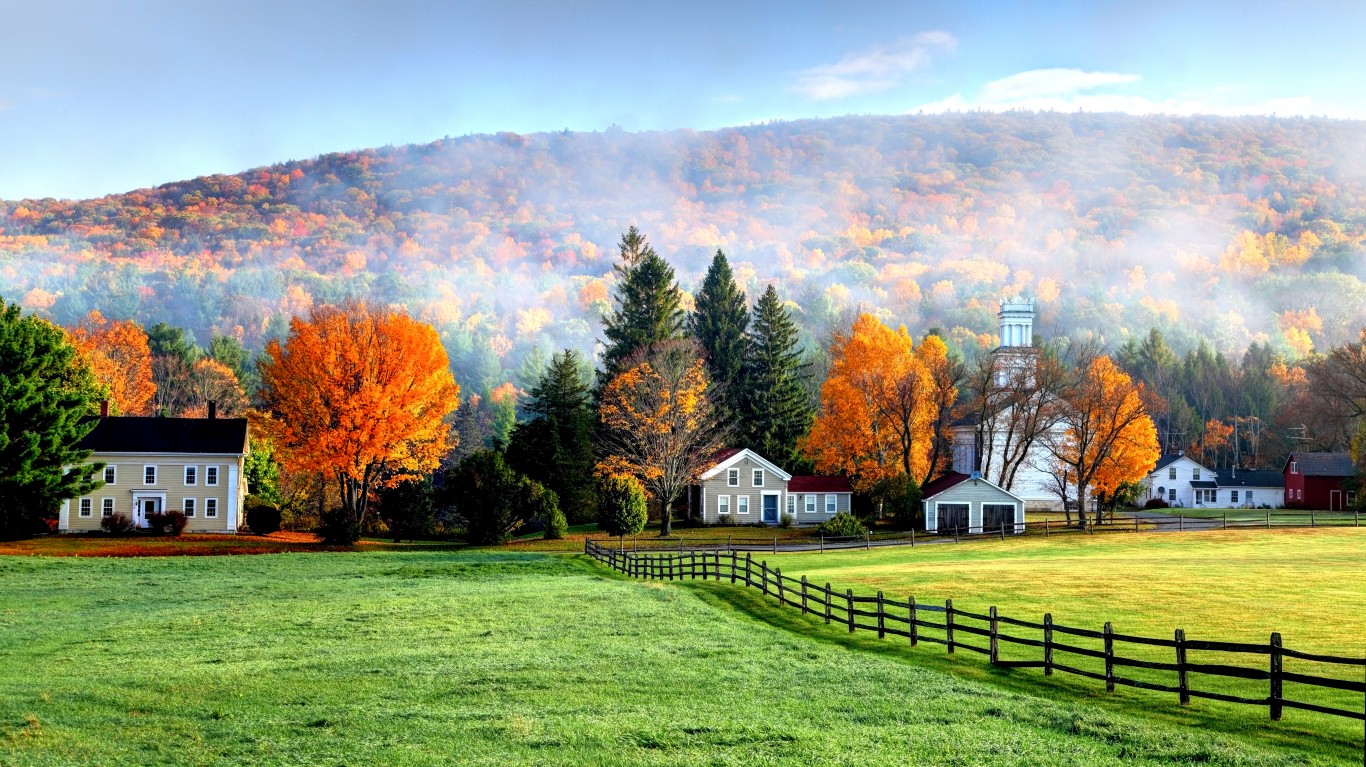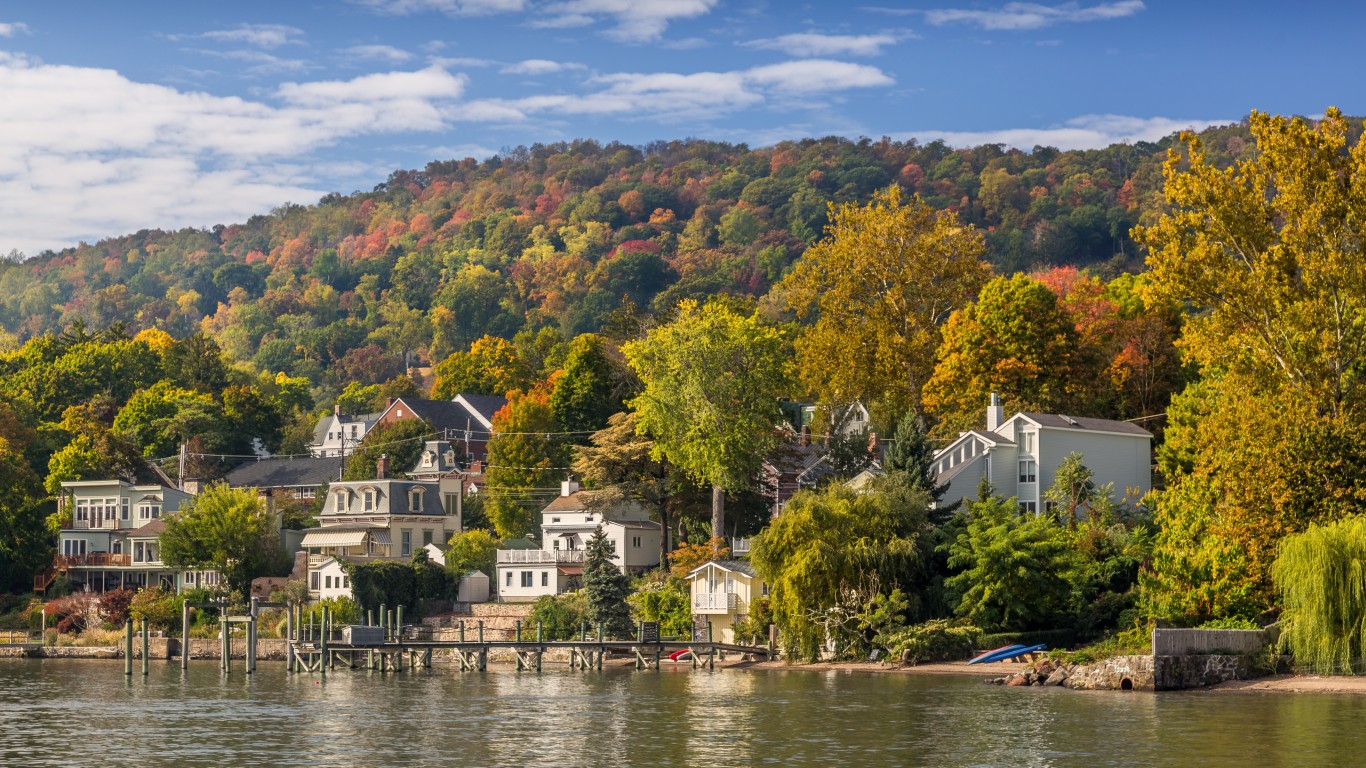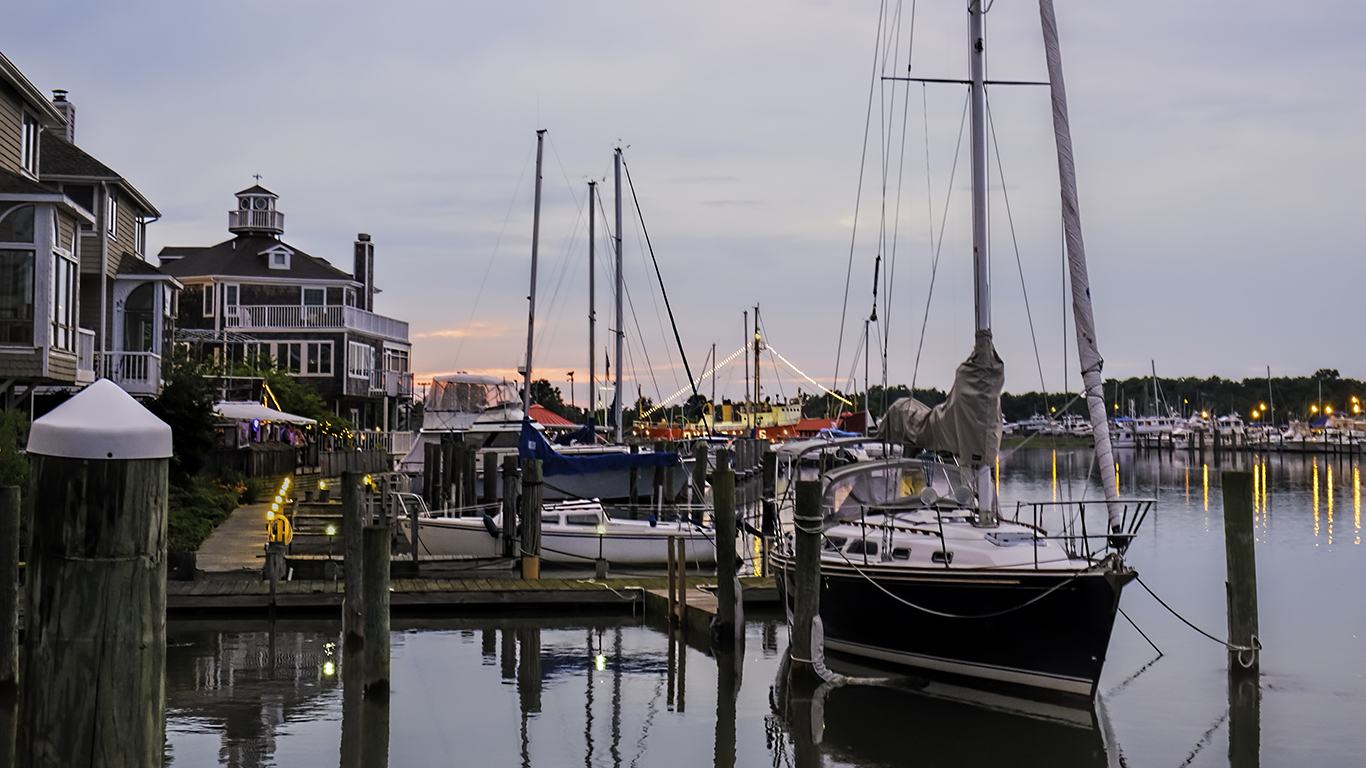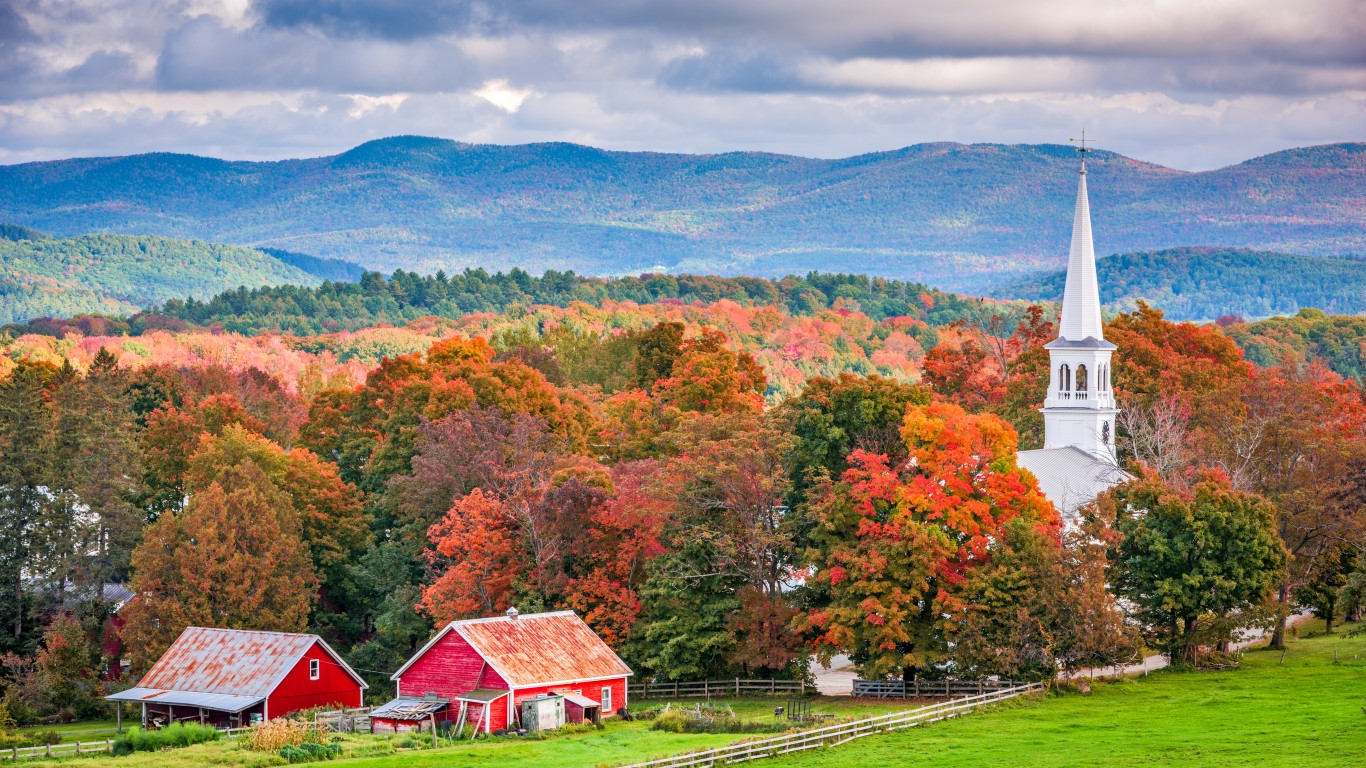
For the nearly 165 million Americans who are fully vaccinated, summer 2021 has brought something of a return to normalcy. Still, in much of the country, experts advise revelers flocking to beaches, parks, and backyard barbecues to remain vigilant of another public health threat — Lyme disease.
Lyme disease is a tick-borne illness that is typically contracted after an infected blacklegged tick attaches itself to an individual for 36 to 48 hours. Nationwide, there were 23,453 confirmed cases of Lyme disease and another 11,492 probable cases in 2019. Over the last three years, there were an average of 7.8 confirmed cases of the disease for every 100,000 Americans.
Early symptoms of Lyme disease include fever, chills, headache, fatigue, muscle and joint aches, and typically either a rash or swollen lymph nodes. Usually the disease can be cured with a course of antibiotics, but if left untreated for more than a month, it can lead to more severe symptoms including severe headaches, facial palsy, nerve pain, numbness, and episodes of dizziness or shortness of breath, among others. Here is a look at symptoms that you may not know are actually allergic reactions.
Using data from the Centers for Disease Control and Prevention, 24/7 Wall St. identified the worst states for Lyme disease. States were ranked on the average per capita infection rate for the last three years of data. Only states considered to be “high-incidence” — meaning at least 10 confirmed cases per 100,000 for three reporting years of the last 10 — were considered. We included Washington D.C. in our analysis.
Those who have been bitten by a tick will often not know, as the ticks are generally about the size of a poppy seed. That is why it is important for those spending time outdoors, particularly in the mid-Atlantic, Northeast, and parts of the Midwest, to check carefully for ticks — especially in hard-to-see areas like the groin, armpits, and scalp.
Click here to see the worst states for Lyme disease.
Click here to see our detailed methodology.

16. Massachusetts
> Avg. new Lyme disease cases per year: 1.7 confirmed cases per 100,000 people
> Total cases in 2019: 7 (6 confirmed, 1 probable)
> Worst year in last decade: 2013; 57.0 confirmed cases per 100,000 people
> Physically active adults: 80.0% (13th highest)
> Uninsured rate: 3.0% (the lowest)
With more than 10 confirmed cases for every 100,000 people from 2010 to 2015, Massachusetts is one of 16 high-incidence states, including Washington D.C., identified by the CDC. However, Lyme disease infection rates have declined precipitously in the state over the last few years. The average infection rate between 2017 to 2019 was just 1.7 per 100,000 people, well below the decade high of 57.0 per 100,000 in 2013. There were a total of only six confirmed cases of the disease in the state in 2019.
Public health officials in Massachusetts dispute the figures reported by the CDC, claiming that the actual number of cases has not declined by over 90%, but rather remained steady in recent years. The disparity may be linked to the CDC’s standard of requiring both a clinical diagnosis and a positive lab test for a case of the disease to be counted — a standard state officials claim is overly burdensome.
[in-text-ad]

15. District of Columbia
> Avg. new Lyme disease cases per year: 8.4 confirmed cases per 100,000 people
> Total cases in 2019: 100 (57 confirmed, 43 probable)
> Worst year in last decade: 2015; 11.6 confirmed cases per 100,000 people
> Physically active adults: 82.6% (5th highest)
> Uninsured rate: 3.5% (2nd lowest)
There are an average of 8.4 confirmed cases of Lyme disease in the District of Columbia annually — a higher infection rate than in all but 14 states. The worst year for the disease over the last decade was 2015, when there were 11.6 confirmed cases per 100,000 people.
Unlike many states with high Lyme infection rates, D.C. is an urban area with relatively little green space. Still, the spring and summer humidity in the area provides ideal conditions for ticks, which can still be found in backyards and parks in the city and pass the disease from mice, rather than deer, as is the case in the Northeastern U.S.

14. Virginia
> Avg. new Lyme disease cases per year: 10.1 confirmed cases per 100,000 people
> Total cases in 2019: 1,199 (788 confirmed, 411 probable)
> Worst year in last decade: 2015; 13.1 confirmed cases per 100,000 people
> Physically active adults: 77.8% (24th highest)
> Uninsured rate: 7.9% (25th lowest)
Virginia is one of several states in the mid-Atlantic region with a relatively high incidence rate of Lyme disease. There are an average of 10.1 cases in the state for every 100,000 people annually, 14th highest among states. Peak transmission in the state occurs in May and June, and residents who spend time in heavily wooded areas are at increased risk.
The state’s infection rate rose slightly in 2019 to 9.2 cases per 100,000 people from 8.7 the previous year. Still, infections remain below the decade high of 13.1 per 100,000 recorded in 2015.

13. New York
> Avg. new Lyme disease cases per year: 14.9 confirmed cases per 100,000 people
> Total cases in 2019: 4,243 (2,847 confirmed, 1,396 probable)
> Worst year in last decade: 2013; 17.9 confirmed cases per 100,000 people
> Physically active adults: 76.6% (19th lowest)
> Uninsured rate: 5.2% (8th lowest)
The average incidence rate of Lyme disease in New York state of 14.9 cases per 100,000 people annually is the 13th highest among states. There were 2,847 confirmed cases in 2019 and another 1,396 probable cases that were not factored into the infection rate.
While much of New York is forested and rural — areas that many associate with higher risk of Lyme disease — those in urban parts of the state still face some risk. Over 40% of the state’s population live in New York City, where parks and backyards can be an ideal habitat for disease-carrying ticks. There have been as many as 1,000 confirmed cases in a single year in New York City.
[in-text-ad-2]

12. Maryland
> Avg. new Lyme disease cases per year: 15.9 confirmed cases per 100,000 people
> Total cases in 2019: 1,417 (804 confirmed, 613 probable)
> Worst year in last decade: 2016; 21.2 confirmed cases per 100,000 people
> Physically active adults: 78.1% (21st highest)
> Uninsured rate: 6.0% (13th lowest)
As is the case across the United States, Lyme disease is the most common tick-borne disease in Maryland. There are an average of 15.9 confirmed cases of Lyme disease in the state annually for every 100,000 people, the 12th highest rate among states.
Mid-Atlantic states such as Maryland tend to have warm and humid spring and summer seasons, which are ideal conditions for blacklegged ticks. However, cases of Lyme disease appear to be becoming increasingly less common across Maryland. The incidence rate of Lyme has fallen each year since hitting a decade peak of 21.2 cases per 100,000 people in 2016. There were only 13.3 confirmed cases per 100,000 people in the state in 2019.

11. Minnesota
> Avg. new Lyme disease cases per year: 19.5 confirmed cases per 100,000 people
> Total cases in 2019: 1,528 (915 confirmed, 613 probable)
> Worst year in last decade: 2013; 26.4 confirmed cases per 100,000 people
> Physically active adults: 80.4% (10th highest)
> Uninsured rate: 4.9% (6th lowest)
Minnesota is one of only two Midwestern states classified as high-incidence for Lyme disease by the CDC — meaning it has had at least 10 confirmed cases per 100,000 people for three reporting years. Over the last three years, there have been an average of 19.5 confirmed cases of Lyme in the state for every 100,000 people, the 11th highest rate among states.
Not only do parts of Minnesota offer blacklegged ticks a suitable habitat, but residents of the state appear more likely to come into contact with disease-carrying ticks by engaging in outdoor activities. Over 80% of adults in the state are regularly physically active, one of the higher shares among states.
[in-text-ad]

10. Wisconsin
> Avg. new Lyme disease cases per year: 23.7 confirmed cases per 100,000 people
> Total cases in 2019: 2,178 (1,219 confirmed, 959 probable)
> Worst year in last decade: 2010; 44.0 confirmed cases per 100,000 people
> Physically active adults: 79.7% (14th highest)
> Uninsured rate: 5.7% (9th lowest)
Wisconsin has the highest incidence rate of Lyme disease in the Midwest and the 10th highest of any state nationwide. There are an average of 23.7 known cases of the disease for every 100,000 people per year.
As is the case in much of the country, cases are becoming less common in Wisconsin. There were only 20.9 cases for every 100,000 people in the state in 2019, less than half the 10-year high of 44.0 per 100,000 reported in 2010.

9. Connecticut
> Avg. new Lyme disease cases per year: 32.1 confirmed cases per 100,000 people
> Total cases in 2019: 1,233 (795 confirmed, 438 probable)
> Worst year in last decade: 2013; 58.7 confirmed cases per 100,000 people
> Physically active adults: 80.1% (12th highest)
> Uninsured rate: 5.9% (12th lowest)
Lyme disease was first identified in Connecticut in the 1970s, and today, the state remains one of the hotspots for the disease. There are an average of 32.1 new infections for every 100,000 people annually in Connecticut, more than four times the national incidence rate.
Encouragingly, the disease appears to be becoming less common in the state. There were only 22.3 cases of Lyme reported for every 100,000 people in Connecticut in 2019, the lowest infection rate in the last decade and less than half the 10-year high of 58.7 incidents per 100,000 people reported in 2013.

8. West Virginia
> Avg. new Lyme disease cases per year: 32.5 confirmed cases per 100,000 people
> Total cases in 2019: 885 (703 confirmed, 182 probable)
> Worst year in last decade: 2019; 39.2 confirmed cases per 100,000 people
> Physically active adults: 72.0% (5th lowest)
> Uninsured rate: 6.7% (19th lowest)
West Virginia recently became a high-incidence state for Lyme disease after reporting more than 10 cases for every 100,000 people in 2015, 2016, and 2017. Cases of the disease have continued to increase in the years since, and in 2019, the state reported a 10-year high of 39.2 cases for every 100,000 people.
In light of the recent increase, researchers at West Virginia University are working on developing a vaccine to protect against Lyme disease with the help of a $1.9 million grant from the National Institute of Allergy and Infectious Diseases.
[in-text-ad-2]

7. New Jersey
> Avg. new Lyme disease cases per year: 33.2 confirmed cases per 100,000 people
> Total cases in 2019: 3,619 (2,400 confirmed, 1,219 probable)
> Worst year in last decade: 2015; 43.9 confirmed cases per 100,000 people
> Physically active adults: 73.4% (11th lowest)
> Uninsured rate: 7.9% (24th lowest)
The humidity common in much of the mid-Atlantic region allows tick populations to thrive. In New Jersey, 2,400 people were infected with Lyme disease by blacklegged ticks, and an additional 1,219 people were likely infected in 2019. Over the last three years, there have been an average of 33.2 confirmed cases of Lyme disease for every 100,000 people in the state annually, the seventh highest infection rate of any state.
Encouragingly, cases of the disease are becoming less common in the state. The 2019 infection rate of 27 cases for every 100,000 people is the lowest it has been in New Jersey in at least a decade.

6. Delaware
> Avg. new Lyme disease cases per year: 53.2 confirmed cases per 100,000 people
> Total cases in 2019: 641 (619 confirmed, 22 probable)
> Worst year in last decade: 2011; 84.6 confirmed cases per 100,000 people
> Physically active adults: 72.7% (8th lowest)
> Uninsured rate: 6.6% (16th lowest)
Delaware is one of only six states with an annual Lyme disease infection rate greater than 50 per 100,000 people. There have been an average of 53.2 confirmed cases for every 100,000 people in the state over the last three years.
Though infections have been identified in each of the state’s three counties, cases tend to be concentrated in New Castle, the state’s northernmost county that sits across the Delaware River from New Jersey and shares a border with Maryland and Pennsylvania — three other states that are also considered high-incidence by the CDC.
[in-text-ad]

5. Rhode Island
> Avg. new Lyme disease cases per year: 56.1 confirmed cases per 100,000 people
> Total cases in 2019: 971 (527 confirmed, 444 probable)
> Worst year in last decade: 2018; 62.5 confirmed cases per 100,000 people
> Physically active adults: 76.5% (18th lowest)
> Uninsured rate: 4.1% (3rd lowest)
The Northeastern United States — particularly the New England region — is a hotspot for Lyme disease. Each of the five states with the highest annual incidence rate of the disease is located in the Northeast, and Rhode Island is one of them. There are an average of 56.1 known cases of the disease for every 100,000 people per year in the state.
Cases have climbed considerably in Rhode Island over the last 10 years, from just 10.9 cases per 100,000 people in 2010 to 49.7 per 100,000 in 2019. Infection rates in the state over the last decade peaked in 2018, when there were 62.5 cases for every 100,000 people.

4. Pennsylvania
> Avg. new Lyme disease cases per year: 62.3 confirmed cases per 100,000 people
> Total cases in 2019: 8,998 (6,763 confirmed, 2,235 probable)
> Worst year in last decade: 2017; 72.2 confirmed cases per 100,000 people
> Physically active adults: 78.0% (23rd highest)
> Uninsured rate: 5.8% (10th lowest)
The average incidence rate of Lyme disease in Pennsylvania of 62.3 cases per 100,000 people annually is the fourth highest among states. There were 6,763 confirmed cases of the disease in the state and another 2,235 probable cases, which were not factored into the infection rate, in 2019 alone.
The type of tick that carries Lyme disease was virtually nonexistent in Pennsylvania as recently as the 1960s. Experts attribute its prevalence today to climate change, change in human and animal behavior that may bring ticks closer to population centers, and the regrowth of timber that was initially cut around 1900 that is now providing a habitat for tick populations.

3. New Hampshire
> Avg. new Lyme disease cases per year: 73.6 confirmed cases per 100,000 people
> Total cases in 2019: 1,710 (1,106 confirmed, 604 probable)
> Worst year in last decade: 2013; 100.0 confirmed cases per 100,000 people
> Physically active adults: 79.2% (17th highest)
> Uninsured rate: 6.3% (14th lowest)
There are an average of 73.6 cases of Lyme disease in New Hampshire for every 100,000 people annually. The state, bordered by Vermont, Massachusetts, and Maine, which are classified as high-incidence by the CDC, reported 1,106 confirmed cases and another 604 probable cases in 2019.
The incidence rate of the disease in 2019 of 81.3 per 100,000 people is the state’s second highest annual rate in the last decade, trailing only 2013, when there were 100 cases per 100,000 people.
[in-text-ad-2]

2. Vermont
> Avg. new Lyme disease cases per year: 90.8 confirmed cases per 100,000 people
> Total cases in 2019: 1,064 (706 confirmed, 358 probable)
> Worst year in last decade: 2019; 113.1 confirmed cases per 100,000 people
> Physically active adults: 81.6% (7th highest)
> Uninsured rate: 4.5% (5th lowest)
Cases of Lyme disease have skyrocketed in Vermont over the last 30 years. In the early 1990s, there a dozen or fewer cases a year. In 2019, there were 706 confirmed cases, or 113.1 for every 100,000 people, the most in at least the last decade. The year’s infection rate does not include another 358 probable cases reported in the state. The state’s average annual infection rate of the last three years stands at 90.8 per 100,000, the second highest of any state.
Though Vermonters have been diagnosed with Lyme disease in every county in the state, the disease tends to be concentrated in the southern half of the state — particularly in Bennington, Rutland, and Windham counties.

1. Maine
> Avg. new Lyme disease cases per year: 103.6 confirmed cases per 100,000 people
> Total cases in 2019: 2,167 (1,629 confirmed, 538 probable)
> Worst year in last decade: 2019; 121.2 confirmed cases per 100,000 people
> Physically active adults: 79.2% (16th highest)
> Uninsured rate: 8.0% (25th highest)
Maine is the only state with a Lyme disease infection rate greater than 100 per 100,000 people. There have been an average of 103.6 confirmed cases for every 100,000 people in the state over the last three years, over 13 times higher than the national average. There were 1,629 confirmed cases in 2019, or 121.2 for every 100,000 people, the most in at least the last decade. The infection rate does not include another 538 probable cases reported in the state that year.
Maine is one of the most rural and sparsely populated states in the country, and Mainers are likely to be close to grassy and wooded areas where disease-carrying blacklegged ticks tend to live. According to the Maine Center for Disease Control and Prevention, Lyme disease is found in every county in the state, and children ages 5 to 14 are at especially high risk for the disease.
Methodology
To identify the worst states for Lyme disease, 24/7 Wall St. reviewed data collected by the Centers for Disease Control and Prevention. States were ranked based on the average annual incidence of Lyme disease from 2017, 2018, and 2019 for every 100,000 people. Incidence rates were calculated using confirmed cases only and do not include probable cases.
Only states considered to be “high-incidence” — meaning at least 10 confirmed cases per 100,000 for three reporting years of the last 10 — were considered. We included Washington D.C. in our analysis.
Supplemental data on the share of the population without health insurance came from the U.S. Census Bureau’s 2019 American Community Survey and are one-year estimates. Data on the share of adults who are physically active is from County Health Rankings & Roadmaps, a Robert Wood Johnson Foundation and University of Wisconsin Population Health Institute joint program, and is for the most recent year available.
It’s Your Money, Your Future—Own It (sponsor)
Are you ahead, or behind on retirement? For families with more than $500,000 saved for retirement, finding a financial advisor who puts your interest first can be the difference, and today it’s easier than ever. SmartAsset’s free tool matches you with up to three fiduciary financial advisors who serve your area in minutes. Each advisor has been carefully vetted and must act in your best interests. Start your search now.
If you’ve saved and built a substantial nest egg for you and your family, don’t delay; get started right here and help your retirement dreams become a retirement reality.
Thank you for reading! Have some feedback for us?
Contact the 24/7 Wall St. editorial team.
 24/7 Wall St.
24/7 Wall St. 24/7 Wall St.
24/7 Wall St.


